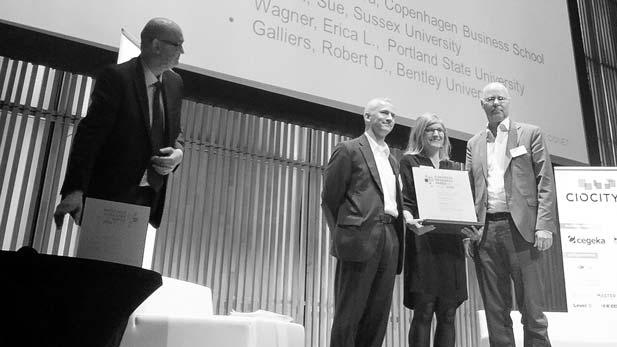IT is about emotions - not only technology

Assistant Professor Mari-Klara Stein and three colleagues were awarded the “European Research Paper of the Year”. Photo: Private
People seem to have a lot of misconceptions and even prejudices when it comes to emotions in the workplace. We often believe that they have no place in rational decision-making and that they cloud our judgment. And among leaders you can sometimes hear the opinion that user resistance to new technology is based on irrational fears, is counterproductive and will have a negative impact on the organisation. Leaders focus on technology, because it appears simpler and easier to control.
A new study from CBS breaks with this understanding, explains Mari-Klara Stein, Assistant Professor at the Department of IT Management.
“The more research I have done in this field, the more I find that the leaders’ way of understanding emotions is often simply not true or not very helpful when it comes to change management,” she says.
This week, Mari-Klara Stein and three colleagues were awarded the “European Research Paper of the Year” for their study “Coping with Information Technology: Mixed Emotions, Vacillation, and Nonconforming Use Patterns”, published in the journal MIS Quarterly in 2015. The initial pool of candidate papers was 18, from which 2 finalists were selected by a jury consisting of people from various companies and academic institutions across Europe. The prize was awarded by CIONET, the biggest community of IT executives worldwide. The award ceremony took place on Monday evening, after Mari-Klara Stein presented the study to an audience of about 200 IT executives at the annual CIOCITY event.
Together with three colleagues, she has studied the implementation of a performance measurement system at two North American universities and examined the role of emotions in how specific IT use patterns emerged. She found five characteristics of IT that were most likely to elicit emotions: IT instrumentality, IT symbolism, identity work, interactions with others and involvement in change.
“IT implementation is never just about technology. Users do respond emotionally to the functionality of IT but also to secondary symbolic meanings that they associate with IT,” she says.
The performance measurement system that Mari-Klara Stein studied, had many features people liked, but it was also seen as a mechanism for management to put employees under surveillance. She explains that if a user is angry enough to vent, but excited enough to want to learn how to use the system anyway, it is likely that the users will find a creative compromise where they can avoid using that part of the IT that makes them angry.
“Yet, and this is crucial, this user pattern may not have any negative organisational consequences. Take the example of an employee entering data into a performance measurement system. If what they enter is accurate, but is framed in a way that makes them look better, this is ‘against the rules’, but does not have a negative impact on management’s ability to make decisions. This is because the data is entirely accurate, and just framed in a way that makes the individual employee feel better,” she says and adds:
“Consequently, it is sometimes less costly and better for organisations to embrace such user behaviours that may seem as ‘resistance’, rather than trying to fight these behaviours and risk alienating their employees.”
According to Mari-Klara Stein, her research offers a better understanding of the role that emotions play in technology use.
“My take-aways for companies and organisations would be, first, not to ignore that IT is more than just about the tool, that users often have mixed emotions, and that this makes them find creative ways to make use of IT. And, second, not to treat all creative rule-bending by users as resistance. Because what these behaviours actually show, is employee commitment and attempts to find a compromise between what is best for them and what is best for the organisation,” she says.
Of course, if we were to conduct this study in a different organisation, different specific emotions and user practices would be found. However, the type of system and problems with user resistance explored by Mari-Klara Stein are familiar to most companies in Western countries.
Read more about the prize
Contact Mari-Klara Stein for questions